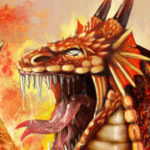 Weird Stuff
Weird Stuff  Weird Stuff
Weird Stuff  Our World
Our World 10 Ways Your Christmas Tree Is More Lit Than You Think
 Movies and TV
Movies and TV The 10 Coolest Stars to Set Sail on The Love Boat
 History
History 10 Things You Didn’t Know About the American National Anthem
 Technology
Technology Top 10 Everyday Tech Buzzwords That Hide a Darker Past
 Humans
Humans 10 Everyday Human Behaviors That Are Actually Survival Instincts
 Animals
Animals 10 Animals That Humiliated and Harmed Historical Leaders
 History
History 10 Most Influential Protests in Modern History
 Creepy
Creepy 10 More Representations of Death from Myth, Legend, and Folktale
 Technology
Technology 10 Scientific Breakthroughs of 2025 That’ll Change Everything
 Weird Stuff
Weird Stuff Ten Bizarre Facts About The Doge Meme
 Our World
Our World 10 Ways Your Christmas Tree Is More Lit Than You Think
 Movies and TV
Movies and TV The 10 Coolest Stars to Set Sail on The Love Boat
Who's Behind Listverse?

Jamie Frater
Head Editor
Jamie founded Listverse due to an insatiable desire to share fascinating, obscure, and bizarre facts. He has been a guest speaker on numerous national radio and television stations and is a five time published author.
More About Us History
History 10 Things You Didn’t Know About the American National Anthem
 Technology
Technology Top 10 Everyday Tech Buzzwords That Hide a Darker Past
 Humans
Humans 10 Everyday Human Behaviors That Are Actually Survival Instincts
 Animals
Animals 10 Animals That Humiliated and Harmed Historical Leaders
 History
History 10 Most Influential Protests in Modern History
 Creepy
Creepy 10 More Representations of Death from Myth, Legend, and Folktale
 Technology
Technology 10 Scientific Breakthroughs of 2025 That’ll Change Everything
10 Medical Conditions Named After Mythical Creatures
In medicine, naming conventions often reflect anatomy, symptoms, or the scientists who discovered a condition. But in rare, memorable cases, doctors turn to mythology—borrowing names from ancient beasts, demons, and creatures of legend to describe bizarre syndromes, rare deformities, or unsettling behaviors. These labels don’t just make for vivid shorthand—they hint at how surreal, mysterious, or misunderstood the conditions once were.
Here are 10 real medical conditions named after mythical creatures, each with strange origins and stranger symptoms.
Related: 10 Unusual, Little-known Facts About the Human Brain
10 Werewolf Syndrome (Hypertrichosis)
Hypertrichosis is one of the rarest medical conditions known to science—with fewer than 100 documented cases worldwide. It causes abnormal hair growth all over the body, including the face, arms, and back, often in thick, dark patches that can resemble fur. The name “werewolf syndrome” didn’t originate in medical literature but rather in sideshows and tabloid headlines, as early cases were so visually dramatic that they seemed supernatural.
The congenital form of the condition is genetic, linked to mutations on the X chromosome. It can be inherited through a dominant pattern, while acquired forms are often triggered by cancer, autoimmune disorders, or medications like minoxidil.
One of the most famous historical cases is that of Petrus Gonsalvus, a 16th-century nobleman from the Canary Islands who had full-body hypertrichosis and was presented to the court of King Henry II of France as a “wild man.” He went on to have several children—some of whom inherited the condition—sparking both scientific curiosity and public fascination. Later in the 19th century, circus performers like Fedor Jeftichew (“Jo-Jo the Dog-Faced Boy”) and Julia Pastrana capitalized on their appearance, though often exploited by promoters.
The condition can be managed in modern times through laser hair removal, shaving, or hormonal treatments. Still, the nickname persists, especially in media, because of its visceral connection to werewolf folklore and the shock factor of excessive hair growth that defies societal norms.[1]
9 Vampirism (Renfield’s Syndrome)
Renfield’s syndrome is a rare and controversial psychiatric condition in which individuals feel compelled to drink blood—human or animal—as part of a compulsive or delusional belief system. The name is derived from the character R.M. Renfield in Bram Stoker’s Dracula, who consumes insects and believes their life force sustains him.
While the syndrome is not officially recognized in the Diagnostic and Statistical Manual of Mental Disorders (DSM-5), several psychiatrists and forensic psychologists have used the term to describe cases where patients exhibit obsessive behaviors centered around blood consumption and vampiric identity.
The condition tends to manifest in phases. It often begins in childhood with self-harm and auto-vampirism (drinking one’s own blood), then escalates to zoophagia (consuming animals), and finally leads to more serious attempts to drink the blood of others. In some extreme cases, it has crossed into criminal behavior.
Richard Trenton Chase, known as the “Vampire of Sacramento,” murdered six people in the late 1970s and drank their blood; psychiatrists later described his delusions in terms consistent with Renfield’s syndrome. While some cases are tied to schizophrenia or personality disorders, others exist in a strange cultural gray area between psychosis and lifestyle choice, as seen in vampire subcultures where blood rituals are performed consensually.
Treatment typically involves antipsychotic medication and intensive therapy. Still, the mythological branding of the condition continues to blur the line between medical phenomenon and gothic horror.[2]
8 Mermaid Syndrome (Sirenomelia)
Sirenomelia, or “mermaid syndrome,” is a fatal congenital defect in which the lower limbs are fused together, forming a single limb or tightly bound pair of legs resembling a mermaid’s tail. The condition is incredibly rare—occurring in roughly 1 in 100,000 births—and results from an abnormal blood flow pattern in the fetus, usually involving the “vitelline artery steal” phenomenon.
This redirected blood flow deprives the lower body of proper nutrients and oxygen, preventing normal development of the pelvis, genitals, kidneys, and lower spine. Most infants born with sirenomelia die within days, often from kidney failure or severe underdevelopment of vital organs. Some rare survivors have lived longer thanks to surgical interventions and round-the-clock medical care.
One of the most widely known cases was Shiloh Pepin, born in 1999 with fused legs, no colon, and no uterus. She underwent multiple surgeries and appeared on national television as the “Mermaid Girl,” capturing public fascination and raising awareness about the condition. Though she passed away at age 10, her case was considered a triumph of medical ingenuity and human resilience.
The mythological label “mermaid syndrome” may seem whimsical. However, it masks a complex, devastating anatomical disorder that challenges surgeons, ethicists, and families alike. Medical literature continues using both “sirenomelia” and the colloquial term interchangeably, keeping the folklore reference alive in clinical and public discourse.[3]
7 Alice in Wonderland Syndrome (AIWS)
Alice in Wonderland Syndrome (AIWS) is a rare neurological condition that causes perceptual distortions of size, shape, and time. People experiencing AIWS may feel that their body or parts of it are growing or shrinking (macrosomatognosia or microsomatognosia), or that external objects are changing size and distance in surreal ways.
The condition is named after Lewis Carroll’s famous fictional narrative in which Alice undergoes bizarre shifts in size and reality perception—experiences that mirror the symptoms reported by AIWS sufferers. Carroll himself may have suffered from migraines or epilepsy, both of which are known triggers for the condition.
AIWS most commonly occurs in children and adolescents and is often associated with migraines, temporal lobe epilepsy, mononucleosis (Epstein-Barr virus), and brain tumors. It can last for minutes or hours and may recur unpredictably. Some people also report distorted time perception, where minutes seem like hours or vice versa.
The condition is difficult to diagnose, in part because it’s so hard to describe and often mistaken for hallucinations or psychosis. Unlike hallucinations, however, AIWS doesn’t involve false sensory input—it’s a misinterpretation of real stimuli, often confirmed by the patient’s awareness that what they’re experiencing isn’t physically possible.
Although it’s considered benign, AIWS is profoundly disorienting, and the literary reference has stuck because no other name so vividly captures the condition’s unsettling blend of fantasy and neurology.[4]
6 Harlequin Ichthyosis (Harlequin Baby)
Harlequin ichthyosis is an extremely rare and severe genetic disorder that affects the skin’s ability to act as a barrier, resulting in thick, armor-like plates of skin with deep, painful fissures. Newborns with the condition have bright red skin encased in large, diamond-shaped scales that often distort facial features, including eversion of the eyelids and lips.
The term “harlequin” refers to the checkered costume of the harlequin clown from Italian commedia dell’arte. However, in this context, it emphasizes the geometric, theatrical, and shocking appearance of the condition. The mutation responsible is in the ABCA12 gene, which is crucial for lipid transport in the epidermis.
Historically, infants with harlequin ichthyosis rarely survived beyond a few days due to dehydration, infections, and respiratory complications caused by skin rigidity. But modern NICU care, antibiotics, and retinoid therapy (especially the drug isotretinoin) have extended survival in some cases into adolescence and adulthood.
Public awareness of the condition increased after the story of Ryan Gonzalez, born in 1986 and believed to be the first long-term survivor. His case forced the medical community to revisit what was once considered uniformly fatal. The condition remains extremely rare—affecting fewer than one in a million births—but its terrifying presentation and distinctive skin pattern keep the mythic, jester-like name in clinical use.[5]
5 Ondine’s Curse (Congenital Central Hypoventilation Syndrome)
Ondine’s curse is a rare and potentially fatal neurological disorder in which the body’s automatic control of breathing fails—most critically during sleep. People with the condition must consciously remember to breathe or rely on mechanical ventilation when unconscious. It’s caused by mutations in the PHOX2 B gene, which is essential for developing the autonomic nervous system.
The congenital form, typically diagnosed in newborns, results in hypoventilation that’s especially dangerous during rest, since the body’s reflexive breathing shuts down. The acquired form can result from brainstem strokes or traumatic brain injury, though it’s far rarer. The name is drawn from the European myth of Ondine (or Undine), a water nymph who curses her unfaithful lover so that if he ever falls asleep, he will stop breathing.
The story, retold in 1930s German plays and early romantic literature, resonated with doctors observing patients who died quietly in their sleep without respiratory distress. The first documented medical usage of the name dates back to the 1960s, when a group of researchers studying central hypoventilation syndrome noted the haunting parallel.
Today, infants with Ondine’s Curse often require a tracheostomy and full-time ventilator support. However, diaphragmatic pacemakers are being explored as a treatment. Even in formal medical literature, the poetic name remains widely used, a rare example of folklore embedded in a diagnostic code.[6]
4 Moebius Syndrome (Linked to the Gorgon Medusa)
Moebius syndrome is a congenital neurological condition that causes paralysis of the cranial nerves—most notably the sixth and seventh—resulting in an inability to move the eyes laterally and a total lack of facial expression. Patients are unable to smile, frown, or raise their eyebrows, giving their faces an unchanging, mask-like appearance. The syndrome is named after German neurologist Paul Julius Möbius, who documented the condition in the late 19th century. However, the blank, wide-eyed gaze and frozen facial posture have drawn comparisons to the mythical Medusa, the Gorgon from Greek mythology who turned anyone who looked into her eyes to stone.
Though the condition is neurological, not muscular, it profoundly affects communication and emotional expression, especially in children. Many individuals with Moebius Syndrome also have limb abnormalities, speech delays, and difficulty feeding. Because the facial immobility can appear unsettling or even “unnatural,” children with the disorder are often subject to bullying or misunderstanding.
Some advocacy organizations have leaned into the Medusa comparison in campaigns aimed at destigmatizing facial difference—recasting her not as a monster, but as a symbol of misjudged appearances. The mythological tie adds a layer of narrative weight to a disorder that, while rare, has a powerful impact on social identity and interaction.[7]
3 Proteus Syndrome (The Elephant Man Disease)
Proteus syndrome is a rare, progressive disorder characterized by overgrowth of skin, bones, muscles, fatty tissues, and blood vessels. Named after the Greek sea god Proteus, known for his ability to change form, it causes different tissues in the body to grow at different rates, often asymmetrically. No two cases of Proteus syndrome are exactly alike, which is precisely why it bears the name of a shape-shifting deity.
The condition results from a mosaic mutation in the AKT1 gene, which occurs after conception and affects only some of the body’s cells, leading to patchy and unpredictable symptoms. The syndrome was unknown to the general public until the case of Joseph Merrick, the so-called “Elephant Man,” gained attention in the 19th century.
For years, it was assumed that Merrick had neurofibromatosis type 1, but later genetic analyses pointed more likely toward Proteus syndrome. In affected individuals, one limb may become dramatically enlarged while the other remains normal. Tumors and abnormal growths may form on the skull or spine, sometimes compromising mobility and organ function.
The disorder is both physically and socially isolating, given its dramatic visual manifestations. There is no cure, and treatment focuses on symptom management, surgical correction, and monitoring for associated health risks. The mythical allusion isn’t just metaphorical—doctors routinely refer to Proteus’s “shape-shifting legacy” in academic literature describing the syndrome’s clinical unpredictability.[8]
2 Cyclopia (Cyclops)
Cyclopia is a rare and usually fatal congenital disorder in which a fetus develops only one eye or partially fused eye sockets in the center of the forehead. The condition occurs due to a failure of the embryonic forebrain to properly divide into two hemispheres, a defect known as holoprosencephaly. This leads to severe malformations of the brain, face, and sometimes limbs.
The condition is so rare that it occurs in fewer than 1 in 100,000 births, and most fetuses affected are either stillborn or die within hours of birth. The name “Cyclopia” derives directly from the mythological Cyclops of Greek legend—giant, one-eyed creatures associated with brute strength and isolation.
Historical texts from various cultures describe births with single eye sockets or craniofacial abnormalities as omens or divine punishments, often leading to infanticide or religious rituals. Fossil records of malformed animal skulls may have contributed to the Cyclops myth in the first place, especially elephant skulls with a central nasal cavity that could resemble a single eye socket to early observers.
In modern times, cyclopia remains a grim diagnosis, most often caught through prenatal ultrasound. The underlying genetic causes can include chromosomal abnormalities like trisomy 13 or exposure to teratogenic substances during pregnancy. Though the myth attached to the condition is thousands of years old, the eerie, central eye still resonates enough to keep the name firmly embedded in medical vocabulary.[9]
1 St. Vitus’ Dance (Sydenham’s Chorea)
St. Vitus’ Dance, also known as Sydenham’s Chorea, is a neurological disorder marked by rapid, involuntary muscle movements that affect the face, hands, and feet. It typically follows a Group A streptococcal infection, such as strep throat. It is one of the major manifestations of rheumatic fever.
The condition is most commonly seen in children and adolescents, particularly girls, and symptoms may last weeks to months. In addition to uncontrollable muscle twitches, patients may experience emotional instability, muscle weakness, and difficulty with fine motor tasks. The medical name honors Thomas Sydenham, a 17th-century English physician who described the condition in detail.
The term “St. Vitus’ Dance,” however, has deeper folkloric roots. In medieval Europe, outbreaks of mass dancing—where individuals would convulse, flail, or move rhythmically for hours—were attributed to curses, demonic possession, or divine punishment. Victims would sometimes gather at the shrine of St. Vitus in hopes of relief. These events were likely mass psychogenic illnesses, but the term stuck and became associated with the jerky, dance-like movements of Sydenham’s Chorea.
The symbolic link between divine frenzy and neurological disorder reflects a time when medicine and myth overlapped regularly. The name still appears in colloquial usage, particularly in historical or religious contexts.[10]








